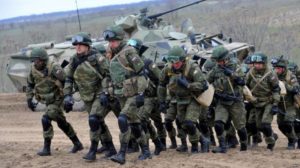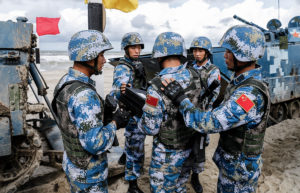Vostok-2018

Russia is about to hold a very large exercise, Vostok-2018, which, for the first time, will involve co-operation with the Chinese PLA, as well as Mongolian forces. Reports talk of some “300,000 troops as well as 900 tanks and aircraft being involved”, as well as a large number of naval vessels. The deployments will take place in central and eastern Russia as well as along the Black Sea coastal area.
As those who have served in the forces will be aware, the numbers can be somewhat academic, with support troops and reserves being mobilised and stood-down at various phases in an exercise. However, the forces involved will still be the largest since the Cold-War era when the West used to crash-out in response to Soviet mobilisation drills. Luckily, the September exercise, called Vostok-2018, will initially take place along the Russo-Chinese border, an area in which clashes between the two countries used to be common.
The Chinese involvement is small but is still more than just symbolic. Mr. Putin’s government views the West (particularly as led by Donald Trump) as increasingly anti-Russian and “frequently aggressive and unfriendly toward us”, according to officials in the Kremlin. (It is reported that this suspicion of the West is now so deep-rooted that Russian officials believe a new, fake chemical-attack is being planned by the US and its allies on Syrian rebels in order to justify another major strike against President Assad’s forces.)

Mr. Gorbachev reversed decades of hostility between China and Russia by his 1989 visit to Bejing. Since then, the friction on the borders has eased off but the threat has always remained as far as the Russians were concerned. More recently, however, Mr. Putin will have started to see China as far more than a quasi-neutral state on his eastern borders. He will have begun to view them as potentially being a major market for Russian goods and services as it expands its wealth to match or exceed that of the USA and Europe.
(There are of course a number of other good reasons to hold the exercise in the east. NATO will find it harder to monitor what is going on, blunders and SNAFUs will be easier to cover up, and it may be assumed that compensation claims for smashing up the open Steppes etc. are going to be far less than for cabbying over valuable agricultural land in the west of Russia.)
Some commentators have suggested that the exercise this autumn is intended to send a clear message to the West telling them that Russia is now capable of “joined-up” strategic operations. That said, Mr. Putin clearly chose not to provoke the West into increasing its forces in Europe and the Baltic by carrying out the exercise in western Russia; the last of the “Zapad” or “West”-based exercises were held in 2017 and caused a lot of concerns in Europe coming as they did so soon after Russia annexed the Crimea. Straight after the end of Zapad 2017, the West carried out its own Dragon-17 exercise which was intended to send the equally clear message to the Russians that the West was prepared to defend its territory.
There is no doubt that these large-scale exercises are part of a new “arms race” between Russia and the West. Russia has been quite open about its view that the build-up of NATO forces along its western border is a prelude to some sort of “aggressive act” and that it is merely acting in response to these. Equally, NATO representatives have commented that Vostok 18 is clearly part of Russia’s “preparation for conflict”. Just who is right, for now at least, is anyone’s guess.
Related Article: Israel Alarmed by New Russian Weapon System

Comments on Large Russian exercise with Chinese participation